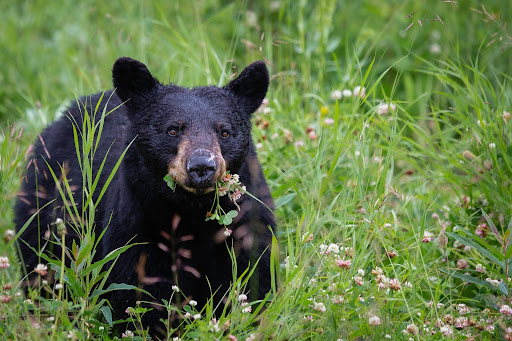When it comes to understanding black bears and their behaviour, misconceptions often abound, leading to unnecessary fear and conflict. One frequently asked question is, “Do black bears eat humans?”
To answer this question, let’s delve into black bear physiology, biology, diet, behaviour, and recorded interactions with humans.
Unique Physiological Traits of Black Bears
Black bears possess several distinctive physical characteristics that aid in their survival.
Hibernation Adaptations
Black bears are known for their remarkable hibernation abilities. During winter months, their heart rate can drop from 40-50 beats per minute to just 8-10, and they can go without food, water, urination, or defecation for up to 100 days.
This ability allows them to conserve energy during periods when food is scarce.
Physical Strength and Speed
Despite their bulky size, black bears are surprisingly agile. They can run up to 30 miles per hour and are excellent climbers and swimmers.
This agility aids in their foraging, escaping from predators, and navigating their diverse habitats.
Black Bears' Ecological Impact
Black bears play a significant role in the ecosystems they inhabit.
Seed Dispersal
As omnivores, black bears consume a variety of fruits and berries alongside meat. Through their scat, they disperse seeds over large areas, aiding in the propagation of many plant species.
Carrion Consumption
By scavenging carcasses, black bears contribute to the decomposition process, cycling nutrients back into the ecosystem, and helping to control the spread of disease.
Black Bears' Cognitive Abilities
Recent research indicates that black bears possess remarkable cognitive abilities.
Spatial Memory
Black bears have an excellent spatial memory that allows them to remember the locations of food sources year after year. This memory even extends to recalling timeframes associated with the ripening of various fruits and berries.
Problem-Solving Skills
Black bears are known for their problem-solving skills, particularly when it comes to accessing food. Whether it’s manipulating latches on bear-proof containers or navigating complex road networks to avoid human interaction, their intelligence is a testament to their adaptability.
In conclusion, the black bear is not just a fascinating creature when it comes to its interactions with humans, but it also holds a significant place in the scientific world due to its unique physiological traits, critical ecological role, and impressive cognitive abilities.
Black Bear Biology and Behaviour
To understand the dietary habits of black bears, it’s crucial first to gain insight into their general biology and behaviour.
Biology and Habitat of Black Bears
The American black bear (Ursus americanus) is the smallest and most widely distributed bear species in North America.
Its natural habitats range from dense forests to subalpine meadows, often in close proximity to food sources. Adapted to life in variable conditions, black bears display significant physiological characteristics that help them survive in different climates and food availability.
Social Structure and Behaviour
Black bears are typically solitary animals, with the exception of mothers with cubs and brief interactions during the breeding season. They exhibit a complex array of behaviours related to feeding, mating, and hibernation.
Understanding these behaviours is key to discerning why black bears might come into contact with humans.
Black Bear Diet
A comprehensive understanding of a black bear’s diet can clarify whether humans are potential prey for these large mammals.
Omnivorous Nature
Black bears are omnivores, meaning their diet comprises a mixture of plants and meat. However, about 85-90% of their diet consists of vegetation – including berries, nuts, and roots – with the remainder made up of insects, fish, and mammals.
While black bears do have the capacity to hunt, most of the animal matter in their diet comes from scavenging rather than active predation.
Food Scarcity and Opportunistic Feeding
Black bears are opportunistic feeders and can adapt their diet based on what’s available. During periods of food scarcity, black bears may venture closer to human habitats in search of sustenance, which often leads to human-bear encounters.
Black Bears and Human Interactions
The likelihood of black bears preying on humans can be assessed by studying their recorded interactions with people.
Frequency of Attacks
Black bear attacks on humans are infrequent. Most black bears tend to avoid human contact and only become aggressive when they feel threatened or cornered, such as when a mother bear is defending her cubs.
Fatalities and Their Causes
While fatalities caused by black bears are extremely rare, they do occur. However, these instances are usually the result of unusual circumstances, such as predatory behaviour from an underfed or habituated bear, rather than indicative of regular feeding habits.
Where Do The Encounters Mostly Happen?
Black bears are quite common across North America and can often be seen along popular hiking trails such as the Appalachian Trail and the Pacific Crest Trail.
Understanding the characteristics and behaviour of bears in these regions can help ensure a safe and enjoyable hiking experience.
Black Bears on the Appalachian Trail
The Appalachian Trail spans about 2,200 miles, passing through a variety of habitats for this specific kind of bear from Georgia to Maine. It’s known for its black bear population, particularly in the Shenandoah National Park and the Great Smoky Mountains National Park.
Shenandoah National Park Black Bears
Black bears in Shenandoah National Park, located in Virginia, are generally accustomed to human presence due to the park’s popularity among hikers and campers. However, they typically keep their distance.
These bears are often seen foraging for berries and other vegetation along the trail.
Great Smoky Mountains National Park Black Bears
The Great Smoky Mountains National Park, straddling North Carolina and Tennessee, boasts one of the highest densities of black bears in the U.S., with approximately two bears per square mile.
Although sightings are common, these bears are often more wary of humans due to stricter regulations on human-bear interactions.
Black Bear FAQ
Do Black Bears Eat Humans?
The current research on black bears, along with anecdotal evidence suggests that black bears do not typically hunt and eat humans. However this does not mean that black bears will not hunt and eat humans if they are in very remote areas and food is particularly scarce.
Black bears would likely consume a human if they were already deceased as scavenging for meat forms a normal part of the diet of black bears.
A review of the scientific literature in 1999 showed that the majority of bear attacks were predacious, meaning that the bear was acting according to its predatory nature. The review also showed that black bear attacks usually resulted in minor injuries.
How Many Black Bears Live in North America?
In 2007 a scientific survey of North American Wildlife Agencies estimated that there were as many as 747,000 black bears, the largest population being in Alaska with a lowball estimate of 72,000 animals.
The study looked at the number of complaints of troublesome black bears in each state which responded to the survey and found that there were approximately 45,000 complaints per year. Most of these complaints were associated with bears attracted by food waste.
What Happens to Black Bears Involved in Human-Bear Conflict?
The same scientific survey mentioned above found that in most cases (75%), the problem bear was relocated. Bears which return to the same area or cause issues elsewhere are unfortunately euthanised either by the state or a licence for hunters is issued.
Most agencies also used a deterrent in the form of rubber bullets to scare off bears, limiting the need for more drastic measures.
How to Avoid Conflict With Black Bears
Since most encounters between black bears and humans happen when food is involved, it is important to take special care when picnicking and if you live in an area with black bears, to dispose of your food waste sensibly.
A study of encounters with black bears in the Great Smoky Mountains National Park found that the human-bear conflicts mostly happened as a result of improper food storage, photography and when visitors ignored the regulations and advice of the National Park Authorities.
Black Bears on the Pacific Crest Trail
The Pacific Crest Trail extends over 2,600 miles from Mexico to Canada, traversing through various wilderness areas across California, Oregon, and Washington. And yes, there are bears on it.
Sierra Nevada Black Bears
In the Sierra Nevada section of the trail, black bears are quite common. They are well-known for their ability to infiltrate food storage, leading to the mandatory use of bear-resistant containers in this area.
These bears have a more brownish colouration, often leading them to be mistaken for grizzly bears, which are not found in California.
Cascade Range Black Bears
In the Cascade Range, stretching across Oregon and Washington, black bears tend to be less habituated to human presence due to the lower visitor density. Encounters are less frequent but still possible.
These bears have access to a diverse diet due to the abundant plant and animal life in these regions.
Black Bears on Other Trails
Black bears can also be encountered on numerous other trails across North America, such as the Continental Divide Trail or various trails in Alaska. Bear behaviour can vary based on the region and their exposure to human activity.
In conclusion, when hiking in bear country, it’s crucial to respect these creatures by keeping a safe distance, securing food properly, and knowing how to react during encounters. These practices not only ensure the safety of hikers but also protect the bears and their natural behaviours.
What To Do When Encountering a Black Bear
While black bears are generally non-aggressive towards humans, encounters can be unpredictable. The following are strategies based on expert advice and bear behaviour studies that can help when you encounter a black bear.
Stay Calm and Assess the Situation
It’s crucial to remain calm and avoid sudden movements that might startle the bear. Assess the bear’s behaviour. If it’s not aware of your presence, slowly back away and leave the area without drawing its attention.
Make Your Presence Known
If the bear has noticed you but does not seem threatened or aggressive, make your presence known. Speak in a calm, assertive voice, and make yourself appear larger by raising your arms or standing on your tiptoes. Avoid direct eye contact as bears may perceive this as a threat.
Do Not Run
Running can trigger a bear’s predatory instinct, causing it to chase you. Instead, move away slowly and sideways; this allows you to keep an eye on the bear without tripping.
Use Bear Spray
Bear spray is a highly effective deterrent in the event of a bear attack. It should be sprayed when the bear is approximately 40-60 feet away (around 15 metres), creating a barrier of pepper spray in its path.
Defensive Measures
In the rare event of a black bear attack, fight back. Use any available object as a weapon, aiming for the bear’s face, particularly the eyes and nose. Black bears often break off their attack once they perceive their opponent as a threat.
It’s worth noting that every bear encounter is unique, and these guidelines may not apply in every situation. If you live or spend time in black bear country, consider taking a course or workshop on bear safety.
It is also beneficial to stay informed about bear activity in your area. These steps will help ensure the safety of both people and bears.
About Discover Tutoring.
We are biologists by training and when we write an article we read the scientific literature to find the most accurate answers to your questions. We do not guess, we do not assume, we check the research. If you are interested in our conclusions and want to find out more, check out the references at the bottom of every page we post on nature.
References –

